Address
304 North Cardinal St.
Dorchester Center, MA 02124
Work Hours
Monday to Friday: 7AM - 7PM
Weekend: 10AM - 5PM
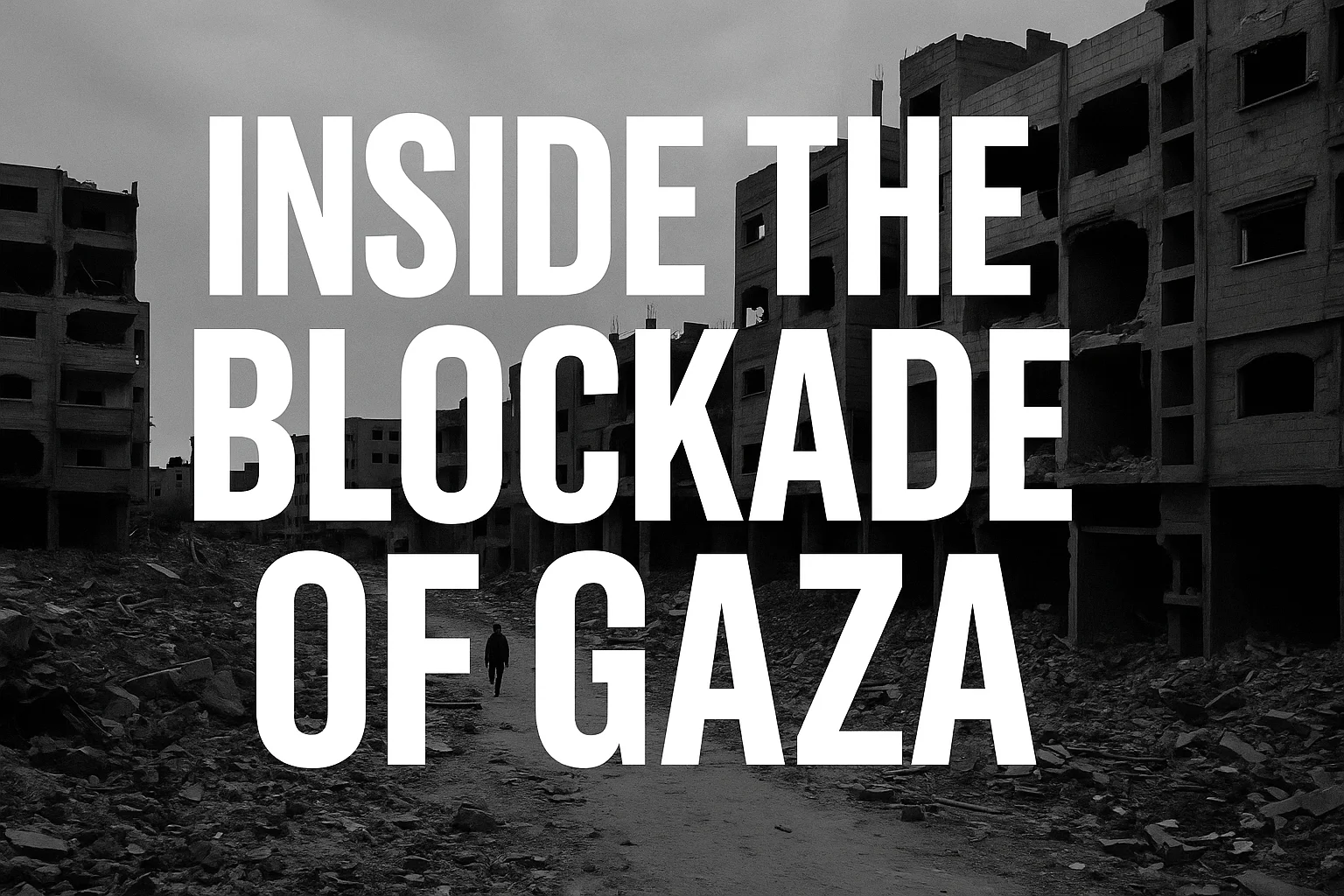
Gaza is not merely a place. In 2025, it is a condition. A physical, psychological, and juridical anomaly—a 140-square mile trauma loop where time doesn’t pass so much as recycle. To the naked eye, it looks like a dense Mediterranean strip of land. To the satellite, it is a prison without a roof. And to the architects of its fate, Gaza is both unsolvable and unallowed to solve itself.
Seventeen years into an unbroken blockade imposed by Israel and enforced, conspicuously, by Egypt, Gaza functions as a pressure valve for every failure of regional diplomacy, every convenient Western abstraction of “security,” and every structural pretext for not recognizing Palestinians as full legal humans. It is not being starved—but it is being managed. And that is, perhaps, more sinister.
Israel claims the blockade is necessary to prevent weapons and materials from reaching Hamas. Egypt parrots the same line while expanding its own internal police state. And the world, with its newfound amnesia and algorithmic moral fatigue, has mostly moved on. Until the next war. Until the next flattening. Until the next photo of a parent digging through rubble for their child briefly disrupts a feed, a conscience, or a government’s press secretary.
But Gaza is not frozen in time. The siege is evolving. It is no longer just a cordon of concrete and tanks. It is digital: drones that hover for weeks, phone networks tapped, databases of every face, every movement. It is economic: a manufactured dependency that turns aid into anesthesia. It is demographic: a majority-youth population sealed off from the future. It is political: a sustained experiment in what the erosion of international norms looks like in real time.
This report is not an appeal to humanitarian sentimentality. It is a hard dissection of the Gaza siege as a strategic doctrine—one that reveals as much about the global order’s hypocrisy as it does about Israel’s. It is about the export of silence, the outsourcing of complicity, and the way the blockade has become a blueprint, not a bug.
This is not a war. This is maintenance.
The blockade of Gaza did not begin with rockets. It began with an election—and a response to the result that sent a message louder than any artillery barrage: Palestinian sovereignty, if it exists at all, will be contingent, revoked at will, and subject to indefinite review.
In January 2006, Hamas—a political movement and paramilitary organization designated as a terrorist group by Israel, the U.S., and the EU—won a majority in the Palestinian Legislative Council elections. The win was neither a surprise nor a coup: it was certified by international observers and reflected widespread frustration with the corruption and impotence of the Fatah-dominated Palestinian Authority. But within months, the democratic verdict became an international liability.
What followed was less a diplomatic response than a geopolitical cordon. Israel, with U.S. and EU backing, froze tax transfers to the Palestinian Authority. Aid was cut. Sanctions intensified. Factional infighting escalated into open conflict between Hamas and Fatah. By mid-2007, after a bloody internal struggle, Hamas expelled Fatah from Gaza and assumed full control of the Strip. Israel, and shortly thereafter Egypt, sealed the territory.
That was the start of the siege.
Framed as a security necessity, the blockade was in reality a punishment—against the political will of Gazans and against the notion that any group hostile to Israel could govern autonomously. It was not just about Hamas rockets. It was about neutralizing an entire political geography.
Since then, the blockade has metastasized into a total system of enclosure. Israel controls Gaza’s airspace, territorial waters, electromagnetic frequencies, population registry, and access to nearly all goods and services. It dictates what materials can enter (cement is “dual-use,” so it’s blocked), what patients can leave, what foods are permissible. Even fishing beyond six nautical miles is a trigger for naval fire. The walls don’t end at the border—they’re buried under bureaucracy, surveillance, and code.
Egypt, too, plays its role—controlling the Rafah crossing with its own political calculus. It fears the contagion of militancy in Sinai, but more recently, its posture has shifted. With Egypt hosting joint military drills with China for the first time in April 2025, it becomes clear that Cairo is realigning its alliances while still keeping one boot firmly on Gaza’s southern neck. The narrative of “security” is elastic. It stretches to fit whomever is useful.
The legal argument for the blockade has always rested on the claim that Gaza is no longer “occupied” since Israel withdrew its military and settlements in 2005. But international law is not as forgiving. Under the Fourth Geneva Convention, a territory is considered occupied if the occupying power retains “effective control”—and by any serious measure, Israel does. From the sky, from the sea, from the algorithm.
Even the Israeli government has dropped pretenses. In 2006, Dov Weisglass, an advisor to Prime Minister Ehud Olmert, told reporters that the blockade’s goal was to “put the Palestinians on a diet, but not to make them die of hunger.” The siege was not meant to kill. It was meant to diminish.
And that is what makes it so effective: death is incidental; control is permanent.
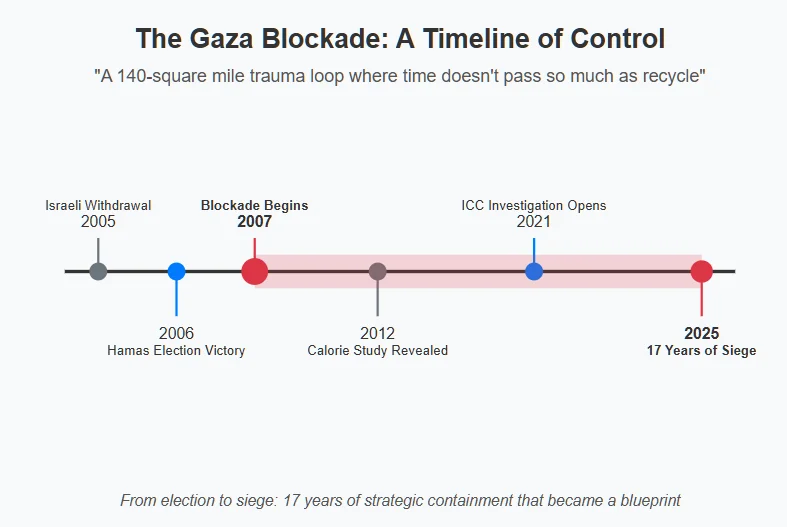
Gaza’s collapse is not a humanitarian crisis in the way that earthquakes or famines are. It is not a failure of nature or logistics. It is a political decision—a calibrated equilibrium of suffering. A disaster whose throttle is regulated by those who claim to prevent it.
By every measurable standard, the Gaza Strip in 2025 is a zone of prolonged civilian catastrophe. As of Q1, the UN Office for the Coordination of Humanitarian Affairs (OCHA) reports that 81% of Gazans require humanitarian assistance. Over 1.6 million people, or roughly 70% of the population, are food insecure. Clean water is scarce—only 4% of groundwater is drinkable, and even that is frequently contaminated. Power cuts average 18 hours per day. Hospitals, already understocked and underpowered, routinely suspend surgeries due to electricity blackouts or lack of anesthetics.
But statistics are a dull knife when applied to Gaza. The violence of this crisis is not always photogenic. It’s a child unable to hear after a missile strike because no ENT specialist has been allowed to leave for training in a decade. It’s a cancer patient waiting on a border crossing that won’t open. It’s a father boiling seawater because the last tanker shipment of chlorine didn’t clear the dual-use import list.
This is what the Israeli coordination system classifies as “a hostile entity” — the human condition.
Critics often frame Gaza as the world’s largest open-air prison. That analogy flatters the prison. In most penitentiaries, inmates receive three meals a day, consistent access to power, and legally guaranteed healthcare. Gaza gets calorie budgets calculated by military planners. Literally.
In 2012, Israeli court documents confirmed that the government had conducted a secret study to determine the minimum caloric intake necessary to avoid malnutrition in Gaza—2,279 calories per person per day. Not to sustain life. Just to avoid its statistical negation. The plan wasn’t implemented in full, but its existence reveals a logic that remains intact: survival without dignity, movement without freedom, existence without autonomy.
And it’s not just infrastructure that’s eroded. The psychological toll is immense. A 2024 report by the Gaza Mental Health Programme found that over 80% of children exhibit signs of trauma-related anxiety or depression. Many have never left the Strip. Most have never seen a night without drones. Their dreams, when they can sleep, are not of freedom—they are of silence.
Education, long a pillar of Palestinian resilience, is also breaking. School attendance remains relatively high, a testament to societal will. But resources are vanishing. UNRWA schools operate in triple shifts. Textbooks are outdated or missing. Teachers are unpaid. Knowledge survives not because of the system, but in spite of it.
Healthcare mirrors this decay. Medical referrals to outside hospitals are tightly restricted. Patients often die awaiting Israeli or Egyptian approval to cross. The healthcare system itself is a patchwork of collapsed institutions: overworked doctors, expired drugs, makeshift dialysis machines held together with car parts. During border clashes in 2024, several hospitals treated mass casualties using kerosene lamps and pre-2008 stockpiled gauze. These are not shortages. These are siege conditions.
Meanwhile, COVID-19 left deep scars that still haven’t healed. Gaza had no ventilators when the virus first arrived, and only one functioning PCR testing site. Vaccination efforts were delayed by months due to border policies, and misinformation flourished in the vacuum. Now, respiratory infections are surging among children, who are more vulnerable than ever in overcrowded shelters with intermittent power and zero air filtration.
The UN, the EU, countless NGOs—they all know this. They issue reports, convene emergency meetings, and allocate band-aids. But their interventions, however sincere, are functionally cosmetic. You can’t repair a structure that is designed to fail. You can’t fix a siege with a spreadsheet.
Gaza’s humanitarian crisis is not an unintended side effect of war. It is a structural weapon. A form of coercion applied through utilities, border control, and paperwork. Its purpose is to erode—not just the will to resist, but the capacity to imagine anything else.
This is not about failing to uphold human rights. It’s about an entire international system designed to tolerate their slow erasure—so long as it happens just out of frame, one delayed crossing, one missed shipment, one denied permit at a time.
This is the crisis. And it is working as designed.
The Gaza Strip is not just sealed by walls and patrolled by drones—it is encoded. Watched. Indexed down to the metadata. If the blockade is the hardware of control, surveillance is its firmware. And in 2025, that software is always on.
Israel’s surveillance apparatus over Gaza is perhaps the most comprehensive implementation of battlefield panopticism in modern history. From constant drone presence to biometric registries, artificial intelligence-assisted facial recognition, and spyware that worms its way through networks and phones, every Gazan lives within a system of algorithmic suspicion.
It starts in the sky. Armed and unarmed drones—some operated by human pilots, others semi-autonomous—maintain constant aerial presence over the Strip. Residents have nicknamed them zanana (“buzzers”), not just for their sound but for their psychological effect. The zanana never leaves. It is the drone as mood, as constant reminder. Children draw them in crayon. Adults whisper when they speak on rooftops.
Every phone call, every text message, every internet login passes through a mesh of Israeli interception systems. Communications are monitored and, in some cases, manipulated. In 2024, Amnesty International documented several Pegasus-like infections across Gaza-based NGOs and journalists. The goal isn’t just intelligence collection—it’s trust erosion. If every message might be monitored, then no one speaks freely.
Gaza’s population registry—who is allowed to live, work, or leave—is still controlled by Israel. Identity itself is a conditional privilege. If you are not in the registry, you don’t exist. If you fall afoul of the algorithm, you become a target. Movement permits are denied not through due process, but through black-box profiling: a shadow file decides your access to cancer treatment, to school abroad, to family reunification.
Facial recognition systems are deployed at border checkpoints and in parts of Gaza near the perimeter. In 2023, a leaked tender from Israel’s Ministry of Defense revealed plans to expand AI-powered recognition software integrated with aerial imagery and “pattern-of-life” behavior prediction tools. The program name? “Blue Dome Analytics”—a sanitized euphemism for total mapping of civilian life – whitewashed as a “friendly fire prevention system.”
This isn’t just surveillance. It’s anticipatory warfare.
Unlike traditional military occupation, which relies on physical presence, this is remote control: domination without footprint. Gaza is not always occupied by boots on the ground—it is occupied by code, by camera, by satellite, by decision-tree.
And what makes this even more disturbing is its exportability. The Gaza model is already being sold. Israeli cyber-intelligence firms have been documented training security forces in Latin America, Southeast Asia, and sub-Saharan Africa. The technologies tested in Gaza—the predictive analytics, the aerial reconnaissance-to-strike loops—are packaged as kill chain “solutions” for counterinsurgency, border control, and urban unrest. Gaza isn’t just a prison. It’s a prototype.
For Gazans, this kind of perpetual mapping breeds a deeper kind of fatigue. Not just fear of death, but fear of visibility. Not just of being watched—but of being watched wrongly, misunderstood by an algorithm trained on misread intent. The difference between an aid worker and a target can be a misflagged movement pattern. The difference between a permit and a no-exit order can be a cousin’s text message.
And in the end, what does it mean to resist something you cannot see, cannot hear, and cannot escape? What happens when the wall isn’t concrete, but data?
Control doesn’t need a boot when it has a database.
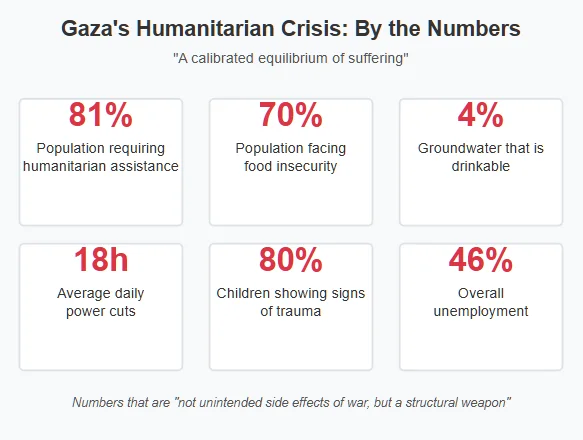
In the post-World War II legal order, the Geneva Conventions were supposed to set limits on what states could do—even to their enemies. Civilians were to be protected. Blockades that starve populations were to be condemned. The line between security and punishment was supposed to be guarded by law.
In Gaza, that line has been erased—and redrawn as policy.
Under Article 33 of the Fourth Geneva Convention, collective punishment is explicitly prohibited: “No protected person may be punished for an offense he or she has not personally committed.” The blockade of Gaza, however, operates precisely on that logic. It is not targeted at individuals or even clearly identifiable military objectives. It is aimed at a population. Two million people are treated as extensions of a political entity they did not vote for, do not control, and cannot escape.
Israel argues, predictably, that the blockade is a form of legitimate self-defense against a hostile, armed faction—Hamas—that has committed repeated attacks and refuses to recognize its right to exist. This framing allows Israel to position its policies as exceptional, necessary, and reluctantly applied. But even within that logic, international law draws boundaries.
Proportionality and distinction are the twin pillars of international humanitarian law. Proportionality demands that military force not cause harm to civilians excessive in relation to the anticipated military advantage. Distinction demands that civilians be differentiated from combatants at all times. Yet when entire medical supply chains are blocked because rubber tubing is considered “dual-use,” or when agricultural fertilizer is banned en masse because it might be repurposed into explosives, the logic of war stretches into the absurd.
The problem isn’t just the blockade’s existence—it’s that it has become routinized. Bureaucratized. Legalized in all but name. In 2021, the Israeli Supreme Court declined to rule against the calorie budgeting policy—because it had never technically been implemented. In 2023, a UN Human Rights Council report concluded that the siege on Gaza “may amount to collective punishment,” but used the word may as both hedge and shield.
International institutions know what’s happening. They write the reports, hold the emergency sessions, tweet the condemnations. But none of it has teeth. The International Criminal Court (ICC) opened an investigation into potential war crimes in the Palestinian territories in 2021—but Israel, not being a party to the Rome Statute, has refused to cooperate. The United States and several European powers oppose the probe, claiming it “unfairly targets” Israel. Meanwhile, the siege continues. Uninterrupted. Unaccountable.
Legal mechanisms exist. Enforcement does not.
Even the notion of Gaza as “not occupied” is a legal fiction that allows Israel to evade responsibilities as an occupying power while maintaining total control. The International Committee of the Red Cross (ICRC) and several legal scholars reject this position, pointing to Israel’s continued control of Gaza’s borders, airspace, population registry, and customs. Under international law, occupation is defined by “effective control,” not presence. And by that metric, Israel remains the sovereign power over a territory it claims not to occupy.
But perhaps the most damning legal implication of the blockade is not what it does to Gaza—it’s what it does to the international system itself. The normalization of exception. The habituation of lawless policy as precedent.
Because if you can blockade a civilian population for 17 years, calculate its caloric intake, deny cancer patients exit permits, and bomb its hospitals without consequence—what, exactly, is international law protecting?
This isn’t just a legal vacuum. It’s legal nihilism.
And Gaza, once again, is its proving ground.
If Israel holds the keys to Gaza’s air, sea, and electromagnetic spectrum, then Egypt controls its last artery: the southern land border at Rafah. While often framed as Gaza’s “Arab lifeline,” the Rafah crossing is less an escape hatch than a heavily fortified valve—opened and closed according to Cairo’s own interests, not Gaza’s needs.
Since 2007, Egypt has largely mirrored Israel’s policy of siege, sealing the Rafah crossing during periods of conflict or political friction and tightly controlling the flow of people, goods, and aid. The justification echoes Israel’s: security. Hamas, after all, is an offshoot of the Muslim Brotherhood, which Egypt’s military regime has labeled a terrorist organization. And Gaza, in the Egyptian narrative, is a destabilizing overflow chamber—a pressure cooker that must never vent into Sinai.
But beneath the rhetoric lies realpolitik. Egypt’s blockade participation is not just about Hamas—it’s about maintaining leverage, extracting concessions, and shaping the narrative of regional power.
And in 2025, that narrative is changing.
In April, Egypt conducted joint air force drills with China—“Eagles of Civilization 2025”—marking the first-ever military exercises between the two nations. The symbolism was deafening. At a time when U.S. influence in the region continues to erode under the Trump Doctrine and the Global South is reconfiguring its alliances, Cairo’s pivot toward Beijing signals a broader strategic recalibration. Egypt is no longer content being Washington’s junior partner or Tel Aviv’s quiet collaborator. It wants to be a sovereign broker—of access, of energy, of information.
Gaza becomes a piece on that board.
By cooperating with Israel on the siege, Egypt signals stability to its Western patrons. By maintaining the blockade on its own terms, it prevents Hamas from gaining regional legitimacy. And by aligning with China militarily, it tells the world: we have other options now.
But this balancing act has devastating consequences for Palestinians.
Rafah is not a functional crossing—it is a point of selective passage, governed by opaque security procedures, bribes, political pressure, and arbitrary denials. Medical patients, students, and dual nationals are frequently stranded for weeks. During the COVID-19 pandemic, dozens died awaiting exit. In the 2024 winter floods, Egypt delayed the entry of construction equipment and fuel for over a month while Cairo negotiated new aid terms with European envoys.
None of this is accidental. Egypt’s blockade role is not a footnote to Israel’s—it is an extension of it. But it is also a demonstration of its own rising autonomy. Cairo is playing the long game, leveraging Gaza not just as a buffer, but as a bargaining chip.
Human rights groups have been muted in their criticism of Egypt’s Gaza policies—partly due to diplomatic sensitivities, partly due to donor dependence. But silence is complicity. Egypt has built a wall along the Gaza border that rivals Israel’s in height and surveillance tech. It has flooded smuggling tunnels with seawater. And its media portrays Gaza not as kin under siege—but as chaos under quarantine.
In many ways, Egypt’s policy toward Gaza is even more insidious. While Israel makes no secret of its strategy, Egypt performs solidarity in public while enforcing siege in practice. It wears Arab unity like a mask—and uses it to suffocate.
The result is a trap with no exits. Gazans are crushed between a hostile occupier and a cautious jailer, between drones and denials, between military strategy and Arab realignment.
Gaza is not just isolated—it is orphaned.
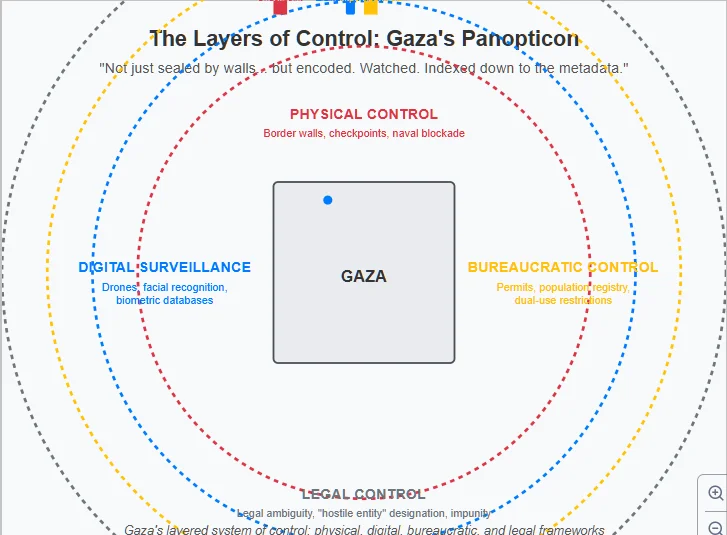
To understand Gaza is to confront a dual captivity. One prison is built of blockade, drones, and diplomatic indifference. The other is internal: ideological rule without renewal, governance by a resistance movement that long ago calcified into authority. At the center of that contradiction stands Hamas—both ruler and resistor, state and sub-state, symbol and saboteur.
Since violently ousting Fatah from Gaza in 2007, Hamas has governed the Strip with a hybrid approach: part militant infrastructure, part welfare apparatus, part authoritarian regime. Its early popularity stemmed from a blend of religiosity, defiance, and social service provision. But nearly two decades of siege, war, and political isolation have drained the movement’s legitimacy. What remains is control.
Hamas maintains power through a combination of coercion, patronage, and narrative monopoly. Dissent is not tolerated. Journalists, activists, and youth critics are routinely detained or intimidated. Civil society operates in a state of conditional toleration—useful so long as it aligns with the political message of resistance, but repressed the moment it critiques domestic mismanagement.
And there is much to critique.
Corruption is widespread, with elite families tied to Hamas benefiting from smuggling monopolies and preferential hiring. Essential goods—when they do enter Gaza—are often diverted, taxed, or rerouted through internal patronage networks. Unemployment hovers near 50%. For youth, it’s worse. There is no functioning electoral process. There is no space for rival parties. There is only stagnation behind slogans.
Yet Hamas still commands a loyal base. Why?
Because in the absence of a viable political horizon, many Gazans see no alternative. The Palestinian Authority, led by the aging and discredited Mahmoud Abbas, is viewed as impotent and complicit, coordinating with Israeli intelligence while failing to deliver even rhetorical victories. The Arab world, once a vocal champion of Palestinian liberation, has normalized with Israel and moved on. The UN shuffles paper. The world tweets prayers. Only Hamas, however flawed, still projects the image of resistance.
And resistance still matters.
Armed factions within and alongside Hamas—Al-Qassam Brigades, Palestinian Islamic Jihad, and smaller groups—continue to fire rockets into Israel, often with symbolic timing rather than strategic utility. These attacks, though largely intercepted by Israel’s Iron Dome, serve as declarations: Gaza is not silent. Gaza is not tamed.
But these bursts of violence are not cost-free. They invite massive Israeli reprisals, often devastating civilian infrastructure. And they feed the narrative—both in Tel Aviv and in Western capitals—that Gaza is inseparable from terror. That no distinction exists between militant and mother, between tunnel and classroom.
This is the central tragedy of Hamas rule: it traps Gaza in a performance loop. Resistance is necessary—but it is also political theater. Governance is possible—but only under siege logic. Hamas cannot win the war, cannot end the siege, and cannot relinquish power without risking fragmentation or retaliation. So it stays. So it governs. So it rules—not just with rockets, but with resignation.
And for many Gazans, the result is a government that is at once theirs and not. Elected once. Entrenched ever since.
Two million people, most of them under 25, have never voted. Most have never left. And many have never known a single day without Hamas.
The Israeli blockade may define Gaza’s borders. But Hamas defines its bandwidth.
This is not liberation. This is lockdown politics.
Gaza’s economy isn’t collapsing—it was engineered to fail. It is not dysfunction. It is design.
What exists today in Gaza is not a functioning economic system but a strangled micro-economy held together by tunnels, remittances, and the inertia of human need. And while the blockade is the most visible mechanism of that collapse, the deeper sabotage lies in its controlled dependence: every shekel of fuel, every kilo of flour, every permit to export or import, is tied to a system that was built not to develop—but to deny.
Before the blockade, Gaza’s economy was weak but integrative. Tens of thousands of Gazans worked in Israel. Goods flowed (albeit unequally) through Israeli ports. Gaza’s fishing and agricultural sectors were lifelines. That’s all gone. Today, unemployment stands above 46%, with youth unemployment over 60%. Over 80% of the population depends on humanitarian aid for survival—primarily from UNRWA and international NGOs. But even this is volatile: donor fatigue, geopolitical horse-trading, and rising global crises have slashed aid contributions year after year.
The private sector? Effectively dead. Factories bombed. Farms bulldozed. Construction banned unless vetted. Nearly all raw materials for production—cement, steel, fertilizers—are categorized as “dual-use” by Israel and denied entry. Gaza’s few surviving industries (furniture, garments, agriculture) function as ghosts of what they once were, operating at 15–25% capacity. Entire families rely on black market trade through underground tunnels, which are repeatedly destroyed or flooded by Egypt.
And yet—Gaza still exports.
In 2025, key exports like strawberries, herbs, and furniture trickle out under heavy Israeli coordination. But “export” is a generous term for goods sold under strict quota to Israeli middlemen, often at far below market value, and with near-total dependency on unpredictable border schedules. The economy is not sovereign. It is hostage to micro-permissions: this shipment, that hour, that route, that approval.
There is no currency of their own. The economy runs on Israeli shekels, creating a paradox of fiscal occupation—where your economy is pinned to the currency of your captor. Inflation in Tel Aviv becomes scarcity in Rafah. A decision by the Bank of Israel ripples through Gaza’s souks and bakeries, but no one in Gaza sits at that table.
Then there’s the border economy—a brutal parody of commerce. Thousands line up daily for permits to work inside Israel, often for low-wage, high-risk labor. These permits are not rights. They are instruments of control. At any sign of unrest, they are revoked en masse. A single incident can close the tap, collapse the cashflow, starve families for months. In this sense, the economy isn’t a casualty of the blockade—it’s an extension of it.
The World Bank has repeatedly warned that Gaza’s economy is in “freefall.” But the fall isn’t free—it’s managed. A carefully modulated collapse that keeps the population poor, but not starving; angry, but not erupting; broken, but still breathing. Israel’s leadership has described this openly. As one unnamed military source told Haaretz in 2020, the goal is to “keep Hamas busy with sewers and salaries.” That is, to replace resistance with administration—without allowing either to stabilize.
This is economic warfare by bureaucracy. Infrastructure is kept just functional enough to avoid total implosion—but never enough for recovery. And foreign aid, paradoxically, becomes part of the machinery: it fills the holes left by siege, but it also defers collapse long enough to prevent diplomatic consequences.
What remains is an economic ecosystem that functions like a pressure cooker. It traps labor, stifles production, and redirects energy inward. Entrepreneurship becomes survivalism. Innovation becomes black market improvisation. Everything becomes a workaround.
Gaza doesn’t have an economy. It has an extractive survival algorithm.
And like everything else in Gaza, it is built to fail just slowly enough to be forgotten.
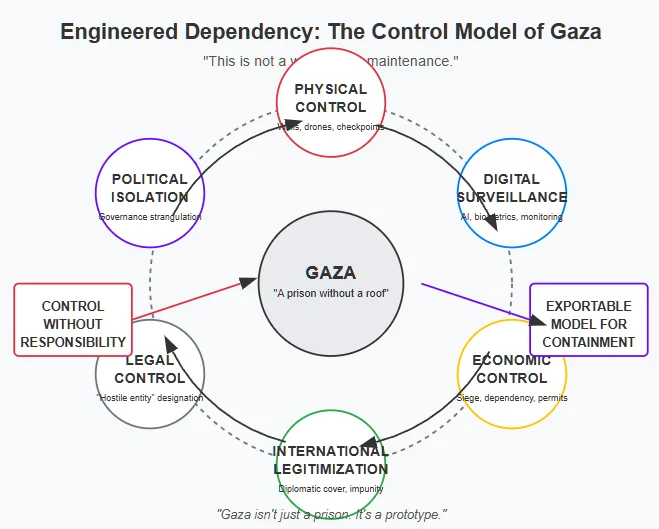
The world knows. The world has known. Gaza’s collapse isn’t a secret—it’s a broadcast.
The reports pile up like rubble: from the UN, the Red Cross, Human Rights Watch, Amnesty International. Photographs of children in makeshift ICU beds lit by cell phones. Graphs showing caloric intake per district. Legal briefs filed in The Hague. And every time the bombs fall, the cycle restarts: condemnation, resolution, veto, silence.
The international community is not paralyzed. It is complicit.
Let’s start with the United States—Israel’s primary military, diplomatic, and economic backer. Every year, Washington provides over $3.8 billion in military assistance to Israel, much of it unconditional. While successive administrations have expressed “concern” over Gaza, none have conditioned aid on measurable change. The few congressional attempts to impose limits—mostly symbolic—are routinely crushed by bipartisan inertia or AIPAC-backed pressure campaigns. And the UN Security Council, where U.S. veto power holds court, has seen resolution after resolution on Gaza rendered inert before ink dries.
The European Union, for its part, plays both cop and counselor. EU member states publicly condemn the siege while simultaneously conducting arms trade, joint surveillance research, and import-export coordination with Israeli firms—some of which directly service the Gaza perimeter. Brussels funds UNRWA to feed children by day, then greenlights tech transfers to the firms engineering their confinement by night.
Canada, Australia, Japan—each holds press conferences, calls for “de-escalation,” and quietly signs bilateral defense or intelligence-sharing agreements with Tel Aviv. The hypocrisy isn’t strategic. It’s structural.
Meanwhile, the Arab world, once Gaza’s loudest voice, has normalized, neoliberalized, and looked away. The Abraham Accords turned Palestinian liberation from a core Arab issue into a diplomatic inconvenience. Saudi Arabia, while still outside the formal framework, hosts think tanks floating post-Gaza “Marshall Plan” fantasies—blueprints that imagine Gaza as a tourist coast if only Palestinians stopped resisting.
And the NGO-industrial complex? It funds reports, stages awareness campaigns, and builds token water projects that are destroyed every three years. Humanitarianism without politics. Aid without pressure. Witnessing as performance.
Even the International Criminal Court, which opened a formal investigation into potential war crimes in Gaza in 2021, has moved at the pace of a UN printer jam. Israel, not a party to the Rome Statute, refuses jurisdiction. The United States opposes the probe. And while warrants may be issued eventually, their enforcement would require political will that simply does not exist.
This is not oversight. This is orchestration.
Gaza’s slow destruction has become tolerable to the West because it does not require direct occupation. It does not look like Bosnia. It does not feel like Rwanda. It is incremental, technocratic, legal-adjacent. There are no machetes—just permit lists. No camps—just restricted zones. No famine—just chronic anemia.
This is siege by design, and compliance by performance.
What makes this more dangerous is what it signals: if Gaza can be indefinitely blockaded, bombed, watched, and erased without triggering enforcement, then every authoritarian state just got a green light. The siege becomes exportable. The legal impunity becomes precedent. Gaza isn’t just a humanitarian failure. It’s the model of the next regime.
Because if there is one thing world powers agree on in 2025, it’s this: Gaza must not die—but it must never live.
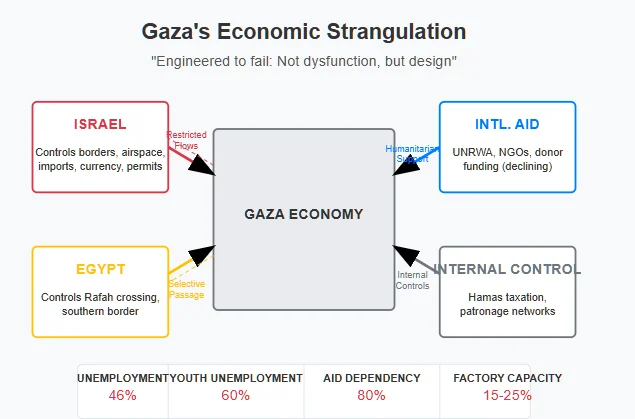
There is no resolution paragraph here. No sweeping gesture toward peace talks brokered in Gulf hotel lobbies. No dreamy two-state solution pasted onto a reality where one side holds biometric control of the other’s children.
There is only this: Gaza is a litmus test. For sovereignty. For law. For resistance. For international will. And the strip is failing—because the world is.
To talk about “peace” without lifting the siege is a bad joke told in policymaker panels. To talk about “de-escalation” while maintaining a matrix of control over food, movement, and medicine is theater. To talk about “security” without accountability is to license the very thing the world once claimed it would never permit again.
So what is the path forward?
First, let’s strip it down:
No future for Gaza is possible as long as the blockade remains.
No stabilization is possible as long as humanitarianism replaces sovereignty.
No accountability is possible as long as international law is a suggestion and not a mechanism.
The blockade must end—not eased, not adjusted, not “recalibrated.” It must be dismantled. Completely.
Border crossings must open—permanently. The right to move, to trade, to breathe beyond the siege must be restored.
International bodies must enforce the laws they pretend to represent. If the Geneva Conventions mean nothing in Gaza, they will mean nothing anywhere soon.
And the narrative must be reclaimed—from those who have collapsed Gaza into a talking point, into a geopolitical punchline, into a case study of “what not to do” while doing it anyway.
This doesn’t mean absolving Hamas or ignoring internal repression. Liberation without democratic renewal is just another cage. But we must reject the framing that makes Palestinian suffering conditional on good behavior. No other occupied or besieged people are asked to perfect themselves before being recognized as worthy of rights.
Gaza must be reimagined—not as a problem to be managed, but as a population to be restored.
And for those watching from outside—the diplomats, the journalists, the academics, the NGOs—understand this: Gaza is not a black swan. It is not an outlier. It is a projection. What is allowed to happen here will shape what becomes possible everywhere else.
Because if the world accepts this—accepts siege as security, surveillance as order, starvation as stability, and legality as decoration—then Gaza is not just occupied. The future is.
Gaza is the world’s moral bandwidth test. And right now, we’re buffering.
[…] to Israel that year – the third-highest annual total on record. These exports continued despite Israel’s bombardment of Gaza and lethal crackdowns in the West Bank (which human rights groups sai… It was only under intense public pressure during Israel’s 2024 Gaza onslaught that Canada […]